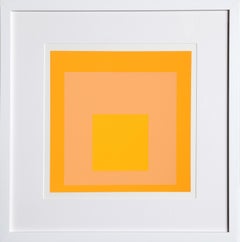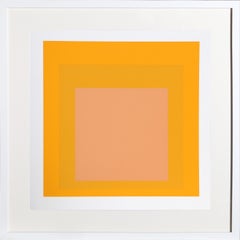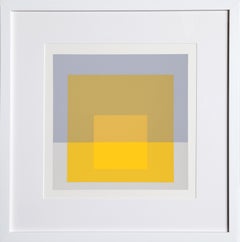Josef Albers Art
The German-born American painter, writer, and educator Josef Albers was a pioneer of 20th century modernism, and an innovative practitioner of color theory. With his wife, the textile artist and printmaker Anni Albers (1899–1994), he shaped the development of a generation of American artists and designers through his teaching at the experimental Black Mountain College in North Carolina, and later at Yale University School of Art, where he was the chairman of the department of design from 1950–1958. Albers is widely known for his series of prints and paintings "Homages to the Square," which he created between 1950 and 1975. His influential volume on color theory The Interaction of Color was published in 1963.
Albers was born in Bottrop, Germany, and as a young man he studied art education, earning certification from the Königliche Kunstschule in Berlin in 1915. He entered the legendary Bauhaus school in Weimar in 1920. The Bauhaus had been established by Walter Gropius in 1919, in the immediate aftermath of World War I, with the hope that its innovative curriculum would foster connections between architecture, art, and traditional crafts. In 1923 Albers began teaching the Vorkurs, the introductory class in which new students learned to work with each of the key artists’ materials, along with color theory, composition, construction and design.
Albers was a polymath, and the multidisciplinary environment of the Bauhaus was fertile ground for his artistic ambitions. When the school moved from Weimar to Dessau in 1925, he became a full professor, and in addition to glass and metal, he designed typefaces and furniture. While at the Bauhaus, Albers drew inspiration from the work of his colleagues, the color theorist Johannes Itten, and the painter, photographer, and designer László Moholy-Nagy, with whom he co-taught the Vorkurs.
In 1933, the Bauhaus was shut down due to pressure from the Nazi Party, which perceived the school as being sympathetic to communist intellectuals. As Albers’ wife Anni was Jewish, the couple resolved to leave Germany, and settled in rural North Carolina. The architect Philip Johnson helped make arrangements for Albers to join the faculty of Black Mountain College as the head of the painting program, where he remained until 1949. While at Black Mountain, both Josef and Anni Albers became influential mentors to American artists including Ruth Asawa, Cy Twombly, and Robert Rauschenberg, while working alongside fellow professors Buckminster Fuller, John Cage, Merce Cunningham and William de Kooning.
In 1950, Albers joined the faculty of the Yale University School of Art where he would head the newly established Department of Design until his retirement in 1958. In the 1950s, the Alberses began taking trips to Mexico, where the colors and forms of the local art and architecture inspired both artists.
In 1971, Albers became the first living artist whose work was the subject of a solo retrospective at the Metropolitan Museum of Art. Though they worked in different mediums, Josef and Anni Albers’ work shares a fascination with color and geometry. Josef Albers’ compositions from the "Homages to the Square" series, such as Formulation: Articulation Portfolio II Folder 28 (B), from 1972, give deceptively simple shapes a novel vibrance as colors play off of one another. The hues in Articulation Portfolio II Folder 28 (B) work in concert to give the flat surface the distinct appearance of a tunnel or other three-dimensional space; while the form on the left appears to move towards the viewer, the form on the right seems to lead directly into the canvas. Similarly, Anni Albers’ designs for textiles use graphic design to lend a sense of dynamism to flat works. Her Study for Unexecuted Wall Hanging (Bauhaus), from 1984 is a Mondrian-like pattern for a weaving in which different colors alternately recede and advance into the foreground, giving the image a sense of complexity and uncanny depth.
Josef Albers also created works of public art, including a delicate, geometric gold leaf mural called Two Structural Constellations for the lobby of the Corning Glass building in New York City in 1959. He designed a work called Two Portals for the lobby of the Time & Life Building in 1961, in which which and brown bands move towards two square panels made of bronze. Walter Gropius invited Albers to create a piece for the Pan Am Building, which he was designing with the architectural firm of Emery Roth & Sons. Albers reworked an existing glass piece from his Bauhaus days called City, and, fittingly, renamed it Manhattan.
Find a collection of authentic Josef Albers art on 1stDibs.
1960s Abstract Geometric Josef Albers Art
Pencil, Screen
1970s Abstract Geometric Josef Albers Art
Screen
1970s Abstract Geometric Josef Albers Art
Screen
1970s Abstract Geometric Josef Albers Art
Screen
1970s Abstract Geometric Josef Albers Art
Screen
1970s Abstract Geometric Josef Albers Art
Screen
1960s Abstract Geometric Josef Albers Art
Screen
1970s Abstract Geometric Josef Albers Art
Screen
1970s Abstract Geometric Josef Albers Art
Screen
1970s Abstract Geometric Josef Albers Art
Screen
1970s Abstract Geometric Josef Albers Art
Screen
1970s Abstract Geometric Josef Albers Art
Screen
1970s Minimalist Josef Albers Art
Screen
1970s Abstract Geometric Josef Albers Art
Screen
1970s Abstract Geometric Josef Albers Art
Screen
1970s Abstract Geometric Josef Albers Art
Screen
Mid-20th Century Minimalist Josef Albers Art
Offset
1960s Abstract Geometric Josef Albers Art
Screen
Late 20th Century Modern Josef Albers Art
Board
1970s Abstract Geometric Josef Albers Art
Screen
Mid-20th Century American Modern Josef Albers Art
Offset
1960s Abstract Geometric Josef Albers Art
Screen
1970s Abstract Geometric Josef Albers Art
Screen
1970s Abstract Geometric Josef Albers Art
Screen
1970s Abstract Geometric Josef Albers Art
Screen
1960s Abstract Geometric Josef Albers Art
Screen
1970s American Modern Josef Albers Art
Screen
1970s Abstract Geometric Josef Albers Art
Screen
1970s Abstract Geometric Josef Albers Art
Screen
1970s Abstract Geometric Josef Albers Art
Screen
1970s Abstract Geometric Josef Albers Art
Screen
1970s Abstract Geometric Josef Albers Art
Screen
1970s Abstract Geometric Josef Albers Art
Screen
1970s Abstract Geometric Josef Albers Art
Screen
1960s Abstract Geometric Josef Albers Art
Screen
1970s Abstract Josef Albers Art
Paper
1960s Abstract Geometric Josef Albers Art
Color, Screen
1970s Abstract Geometric Josef Albers Art
Screen
1970s Abstract Geometric Josef Albers Art
Screen
1970s Abstract Geometric Josef Albers Art
Screen
1970s Minimalist Josef Albers Art
Screen
1970s Abstract Geometric Josef Albers Art
Screen
1970s Abstract Geometric Josef Albers Art
Screen
1970s Abstract Geometric Josef Albers Art
Screen
1970s Abstract Geometric Josef Albers Art
Screen
1970s Abstract Geometric Josef Albers Art
Screen
1970s Abstract Geometric Josef Albers Art
Screen
1970s Abstract Geometric Josef Albers Art
Screen
1940s Josef Albers Art
Woodcut
1970s Abstract Geometric Josef Albers Art
Screen
1970s Abstract Geometric Josef Albers Art
Screen
1970s Abstract Geometric Josef Albers Art
Screen
1960s Abstract Geometric Josef Albers Art
Lithograph
1970s Abstract Geometric Josef Albers Art
Screen
1970s Abstract Geometric Josef Albers Art
Screen
1970s Minimalist Josef Albers Art
Screen
1970s Abstract Geometric Josef Albers Art
Screen
Mid-20th Century Pop Art Josef Albers Art
Offset
1970s Abstract Geometric Josef Albers Art
Screen
1970s Abstract Geometric Josef Albers Art
Screen
Josef Albers art for sale on 1stDibs.
Artists Similar to Josef Albers
- 1stDibs ExpertNovember 20, 2024How much an Homage to a Square is worth depends on its size, history, condition and other factors. For example, Homage to the Square: White Nimbus sold for $2.2 million, while Study for Homage to the Square: With Saffron fetched $915,000. Josef Albers, the artist who produced these works, is widely known for his series of prints and paintings, "Homage to the Square," which he created between 1950 and 1975. He was an innovative practitioner of color theory and published a book on the subject in 1963. If you're in possession of an Albers piece, consider having a certified appraiser or knowledgeable art dealer help you with the valuation process. Explore a variety of Josef Albers art on 1stDibs.
- 1stDibs ExpertNovember 13, 2024A print of an original painting is usually called a reproduction or reproduction print. Today, many reproduction prints are giclée prints. To produce a giclée print, a printmaker first scans a painting, drawing or other work of art. Then, they use a high-quality inkjet printer to transfer the image onto canvas or paper. Explore a large selection of prints on 1stDibs.
- 1stDibs ExpertJanuary 19, 2025The name of prints made so the artist can see the progress of the print is an artist's proof. Since they are made to test the printing process, artist's proofs sometimes vary slightly from regular edition prints. In some cases, the artist's proof is more valuable than a standard print due to its rarity. Shop a wide variety of prints on 1stDibs.
- Who is Josef Albers?1 Answer1stDibs ExpertMarch 22, 2022Josef Albers is an artist associated with the Bauhaus movement who lived from 1888 to 1976. He developed an important color theory hypothesis and employed it in works like his "Homage to the Square" series. On 1stDibs, find a selection of Josef Albers art.
- How did Josef Albers paint?1 Answer1stDibs ExpertMarch 22, 2022Josef Albers usually painted with a palette knife instead of a paintbrush, liking how the increased level of control allowed him to create sharp, well-defined lines. He rarely used a palette, normally applying paint right from the tube. Usually, he produced his pieces on Masonite board to add texture to the compositions. On 1stDibs, find a collection of Josef Albers art.
- How do I pronounce Josef Albers?1 Answer1stDibs ExpertMarch 22, 2022To pronounce Josef Albers, say "JOW-suf ALL-burz." His first name is the German spelling of the English name Joseph and said in much the same way. His last name is also of German origin. On 1stDibs, find a range of Josef Albers art.
- What is Josef Albers known for?1 Answer1stDibs ExpertMarch 22, 2022Josef Albers is known for his work as a painter, educator and writer. His work as an artist helped to define the modern period and advance color theory, changing the way future generations approached their own art. His "Homage to the Square" series contains his most famous pieces. On 1stDibs, find a variety of Josef Albers art.
- What inspired Josef Albers?1 Answer1stDibs ExpertMarch 22, 2022What inspired Josef Albers changed over the course of his life. During the Bauhaus period, his colleagues Johannes Itten and László Moholy-Nagy greatly influenced his work. In the 1950s, Albers and his wife, textile artist Anni Albers, frequently traveled to Mexico to draw inspiration from the local architecture and art. On 1stDibs, shop a range of Josef Albers art.
- Where did Josef Albers teach?1 Answer1stDibs ExpertMarch 22, 2022Josef Albers taught at more than one school during the course of his life. After a brief period of time as an elementary school teacher in Bottrop, Germany, he enrolled in the Bauhaus school and began teaching classes there within a few years. After moving to the U.S., he taught at Black Mountain College in North Carolina and the Yale University School of Art in Connecticut. Shop a range of Josef Albers art on 1stDibs.
- Who were Josef Albers’ parents?1 Answer1stDibs ExpertMarch 22, 2022Josef Albers's parents were Magdalena and Lorenz Albers. His father worked as a handyman, painting houses, performing repairs and doing carpentry jobs, and his mother came from a long line of blacksmiths. You'll find a variety of Josef Albers art on 1stDibs.
- When was Josef Albers born?1 Answer1stDibs ExpertMarch 22, 2022Josef Albers was born on March 19, 1888, in Bottrop, Germany. He would go on to become a leader of the modern art movement and to make huge strides in the area of color theory research. Shop a selection of Josef Albers art on 1stDibs.
- 1stDibs ExpertMarch 22, 2022Josef Albers taught many subjects at the Bauhaus. When he began as a teacher, he oversaw the Vorkurs, the introductory course that reviewed composition, construction, design, color theory and other fundamentals. In later years, he became a full professor and expanded his course offerings. On 1stDibs, shop a selection of Josef Albers art.
- 1stDibs ExpertMarch 22, 2022Josef Albers's color theory holds that the only way to fully understand a single color is to view it alongside other colors. He believed that surrounding colors had the ability to change the perception of a hue, and he used his "Homage to the Square" series to demonstrate this. Find a variety of Josef Albers art on 1stDibs.
- 1stDibs ExpertMarch 22, 2022Josef Albers came to America in 1933 after the Nazis shuttered the Bauhaus. He and his wife, the textile artist Anni Albers, originally settled in North Carolina. During his time there, Albers taught at Black Mountain College. Shop a variety of Josef Albers art on 1stDibs.
- 1stDibs ExpertMarch 22, 2022Josef Albers framed his work in different ways throughout his career, but he is most well known for the compositions of his "Homage to the Square" series. These oil paintings featured bold squares in varying hues that demonstrated how colors impact one another. Albers framed the squares with mathematical precision, masterfully fusing geometry with art. On 1stDibs, find a selection of Josef Albers artistic expression.
- 1stDibs ExpertMarch 22, 2022Over the course of his long career, Josef Albers painted in more than one movement. His early work fits the characteristics of Bauhaus artists, while his later compositions are in line with the features of geometric abstraction. Find a collection of Josef Albers art on 1stDibs.
- 1stDibs ExpertMarch 22, 2022Josef Albers used the same materials throughout his career. Usually, he preferred oil paints, which he applied with a palette knife instead of a brush. Much of his work appears on textured masonite board. Find a selection of Josef Albers art on 1stDibs.
- 1stDibs ExpertMarch 22, 2022Josef Albers taught at an elementary school in the town of Bottrop, Germany, during the early 20th century. The name of the school is unknown. Albers would go on to teach at the Bauhaus and Yale University. On 1stDibs, shop a collection of Josef Albers art.
- 1stDibs ExpertMarch 22, 2022To get Josef Albers paintings appraised, search for certified art appraisers in your area who are knowledgeable about works from the modern period. You may be able to get a rough idea of the value from an online search, but a true determination of what a painting is worth requires a close inspection by a professional. On 1stDibs, find a collection of expertly vetted Josef Albers art.
- 1stDibs ExpertMarch 22, 2022Josef Albers taught at the Yale University School of Art from 1950 until 1958. In addition to instructing classes, he served as the dean of the university's Department of Design. You can find a range of Josef Albers art on 1stDibs.
- 1stDibs ExpertMarch 22, 2022Josef Albers went to more than one school during the course of his life. He attended the Königliche Kunstschule in Berlin and earned a teaching certification after he graduated in 1915. In 1920, he enrolled at the Bauhaus school. Within three years, he began teaching the introductory course at the institution. Shop a collection of Josef Albers art on 1stDibs.
- 1stDibs ExpertMarch 22, 2022No, Josef Albers's art is generally not considered fauve. Fauvism refers to an art movement that lasted from 1904 to around 1910 and included artists like Henri Matisse and André Derain. Although these artists' use of color likely influenced Josef Albers, historians associate him with the Bauhaus movement that lasted from 1919 to 1933. On 1stDibs, shop a variety of Josef Albers art.





